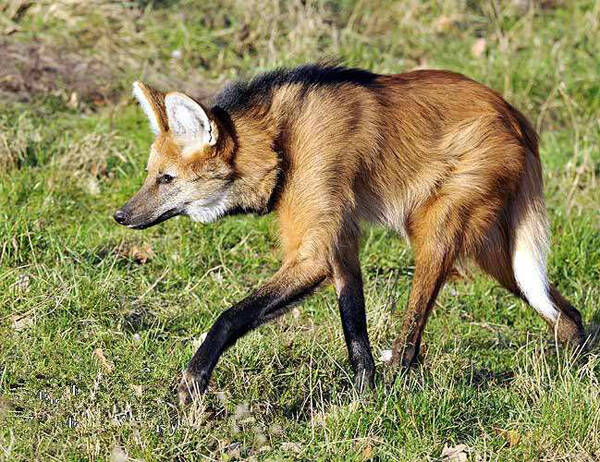Chrysocyon brachyurus
IUCN
LCBasic Information
Scientific classification
- name:Chrysocyon brachyurus
- Scientific Name:Maned wolf, Brazilian wolf, South American wolf
- Outline:Carnivora
- Family:Carnivora Canidae Chrysocyon
Vital signs
- length:120-130cm
- Weight:20-23kg
- lifetime:12-15years
Feature
Has a long golden-red "coat" and a distinctive mane that can stand upright
Distribution and Habitat
It is mainly distributed in Argentina, Bolivia, Brazil, Paraguay, Peru, and may be extinct in Uruguay.
The maned wolf mainly lives in high grasslands, shrubs, etc., mainly in open trees and wetlands, but also likes to move in sparser dry shrubs, and sometimes appears in farmlands and pastures. The maned wolf prefers to live in high grasslands, low forest shrubs and open swampy areas. In Brazil, this species is found in the tropical tall grass grassland (cerrado) area, which is an open woodland and tropical savanna, one of the most important biodiversity "hotspots" in the world.
Appearance
Standing almost a meter tall, the maned wolf is the largest canid in South America. It stands 74-78 cm tall at the shoulder and has a head-body length of 1.2-1.3 meters; it weighs 20–23 kg. It has a long, golden-red "coat". The fur is reddish-brown on the sides, black on the back and legs, and white at the tip of the tail and throat. The distinctive mane can stand up, and when it encounters danger or is about to attack, the maned wolf will expand its body outline to show itself. The muzzle, paws and ear tips are black, while the inside of the ears and the middle of the tail are white.
The name "maned wolf" comes from the characteristic mane-like black fur strips that run from the back of the head to the shoulders, which stand upright when it senses danger. The maned wolf has large upright ears and a long, pointed muzzle, similar in appearance to the red fox. It has a slender body and large, upright ears. The legs are long and thin, like stilts, which helps it to
Details
Maned wolf (scientific name: Chrysocyon brachyurus), also known as Maned wolf in English, is a rare animal of the genus Chrysocyon in the family Canidae, with no subspecies.

Male and female maned wolves have a relatively fixed mate relationship and usually share a territory (about 27 square kilometers), but usually forage alone except during mating season. Maned wolves mark their territories with urine and breath. Territory owners closely monitor their territories. Male maned wolves wandering between territories are always thinking about replacing territory owners.
Maned wolves go out of their dens to hunt several times a day. Generally, they go out after midnight, starting at about 3:30 a.m., and the activity reaches its peak around 6 a.m. After 7:30 a.m., when the sun rises, the maned wolves stop moving and return to their dens to rest, or sleep on a hill for about 4 hours. After 12 noon, the maned wolves start to move again, but not as intensely as in the early morning. They are active for about 6-7 hours in the afternoon, but are not in a hurry to stop. Around 11-12 p.m. at night, it is the last active period of the day.
Maned wolves mainly hunt at night. They are omnivorous animals. The diet includes a variety of fruits, rodents and small mammals such as armadillos, rabbits, birds, reptiles, gastropods and other terrestrial mollusks, insects, fish and arthropods. One of the maned wolf's food sources is the wolfberry (lobeira), which is very similar to tomatoes and grows all year round. It is believed to provide medicinal effects against giant kidney worms (Dioctophyme renate). Occasionally, it also includes steppe deer (Ozotoceros bezoarticus), and sometimes steals poultry and small livestock: for example, stealing free-range chickens from farms.
Maned wolves can make three types of calls. One is a call that is often heard at dusk; another is a high-pitched whine; and the last is a roar when fighting.
Maned wolves usually live in pairs or alone. It is common to see male and female maned wolves together during the breeding season. Maned wolves breed in captivity in the Northern Hemisphere in October and February, and in South America in August and October. The mating period lasts 1-4 days, the gestation period is about 65 days, and each litter has 1-5 pups, with the highest record observed being 7. Newborns open their eyes around 9 days old, start eating solid food around 4 weeks old, their fur turns from black to red at 11 weeks old, and they are weaned at 15 weeks old. They are fully grown and reach sexual maturity in about 1 year. Wild maned wolves are rarely seen with their pups. They live about 15 years in captivity.
The maned wolf is protected by law in many areas of its range. The species is listed as endangered in Argentina; it is in the vulnerable category in Brazil, and hunting is prohibited in Brazil, Paraguay, Bolivia, and Argentina. The species is listed on the U.S. endangered species list. Protected areas: There are many protected areas for this species in Argentina, Bolivia, Brazil, Paraguay, and Peru. Captive: As of January 2012, there were 394 maned wolves (182 males, 211 females, and one unknown) in captivity in 150 institutions.
Listed in the 2015 IUCN Red List of Threatened Species, ver 3.1 - Near Threatened (NT).
Listed in Appendix II of the Washington Convention on International Trade in Endangered Species of Wild Fauna and Flora (CITES) 2019 Edition Appendix II.
Protect wild animals and stop eating game.
Maintaining ecological balance is everyone's responsibility!








